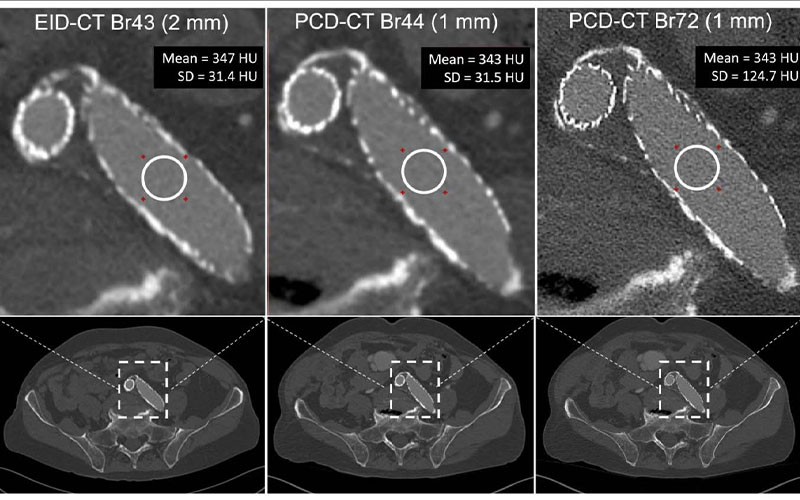First Clinical Photon-Counting CT System Outperforms Current CT
PCD-CT offers physicians views of anatomy and disease at a unique resolution

The first clinical photon-counting-detector (PCD) CT system available for patient care outperforms current state-of-the-art CT systems, according to a new study published in Radiology.
PCD-CT systems have shown several advantages over standard CT, including suppression of electronic noise, improved spatial resolution, and reduced radiation dose. PCDs directly convert X-rays to electrical signal, facilitating small detector pixel designs without loss of geometric dose efficiency and allowing simultaneous multi-energy CT through the use of multiple energy thresholds.
Advances in the detector technology have facilitated translation of PCDs to human imaging at clinical doses and dose rates, demonstrating potential clinical benefits for patients.
With the introduction of the first clinical PCD-CT, the beneficial characteristics of PCDs can be realized in clinical practice. However, a comprehensive performance assessment is needed to confirm current clinical requirements are met and to provide performance benchmarks. Cynthia McCollough, PhD, and colleagues from the Department of Radiology at the Mayo Clinic in Rochester, MN — working with representatives from Siemens Healthineers in Forchheim, Germany, and Siemens Medical Solutions in Malvern, Pennsylvania — set out to assess the technical performance of a clinical PCD-CT.
“PCD-CT is so exciting because it provides information that existing CT detectors – the types that we’ve used for over 50 years – previously just couldn’t capture,” said Dr. McCollough, director of Mayo Clinic’s CT Clinical Innovation Center. “It allows us to scan faster, with lower radiation and contrast media doses, while obtaining higher quality images with greater spatial detail and lower noise levels. For many clinical applications, the improvements in image quality are really striking.”

PCD-CT Showed Superior Spatial Resolution to Current CT
For the study, the researchers analyzed the technical performance of a dual-source PCD-CT system for standard and high-resolution collimations. Noise power spectrum, modulation transfer function, section sensitivity profile, iodine CT number accuracy in virtual monoenergetic images, and iodine concentration accuracy were measured.
Four participants were enrolled between May 2021 and August 2021 in this prospective study and scanned using similar or lower radiation doses compared to same-day exams performed using energy-integrating-detector (EID) CT. Four clinical indications (CT angiography of the coronary arteries and abdomen/pelvis, whole-body low-dose CT for skeletal surveillance, and temporal bone imaging) were selected to illustrate in humans the effects of PCD-CT’s improved technical performance in phantoms. PCD-CT scans were performed at the same or lower radiation dose relative to the clinical exam.
The results showed that PCD-CT demonstrated superior spatial resolution relative to current CT systems and improved noise properties and multi-energy temporal resolution relative to similarly configured EID-CT.
The high-resolution mode of the PCD-CT demonstrated 125-micron in-plane spatial resolution and 0.3 mm longitudinal resolution, the smallest reported to date for a clinical CT system. The PCD-CT system provided 66-ms temporal resolution multi-energy imaging in dual source mode. Noise reduction (up to 47%) or dose reduction (up to 30%) were achieved in study participants using the PCD-CT system relative to a similar CT system equipped with conventional detectors.
“Every time that CT technology has advanced to provide new technical capabilities, new clinical applications have followed,” Dr. McCollough said. “With PCD-CT, we are seeing anatomy and disease at a resolution that has never before been achieved in patients, and that is providing physicians new information and insights—insights that can change patient management. In patients with coronary artery disease, for example, PCD-CT can provide diagnostic quality images in patients who previously were not good candidates for CT imaging of their coronary arteries. This will spare many patients from having to have more invasive types of testing.”
For More Information
Access the Radiology study, “First Clinical Photon-counting Detector CT System: Technical Evaluation.”
Read previous RSNA News stories on CT: